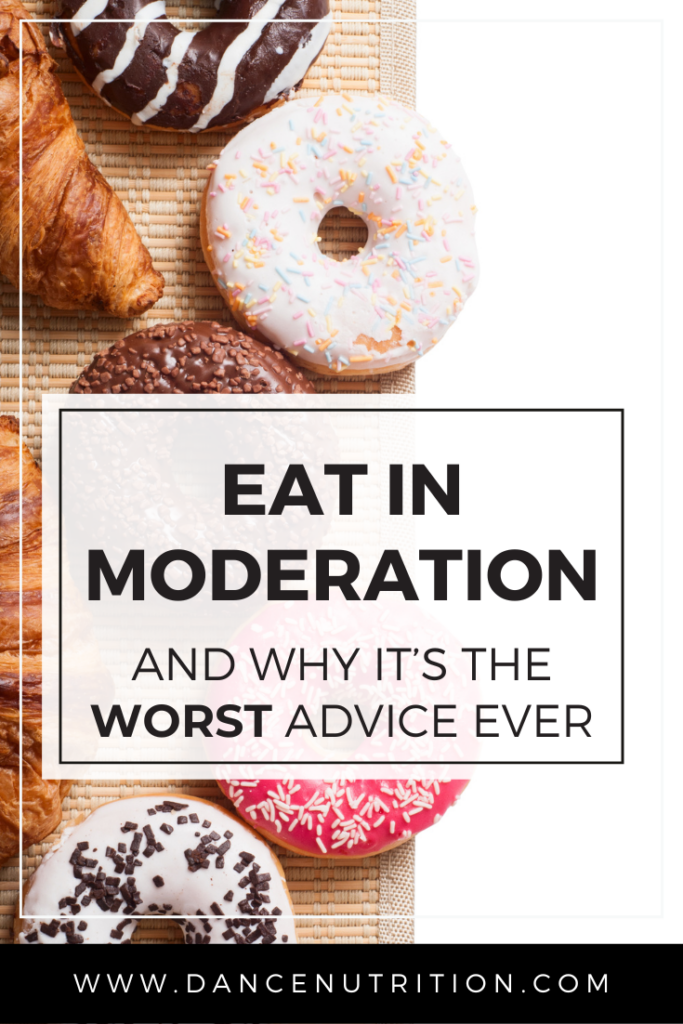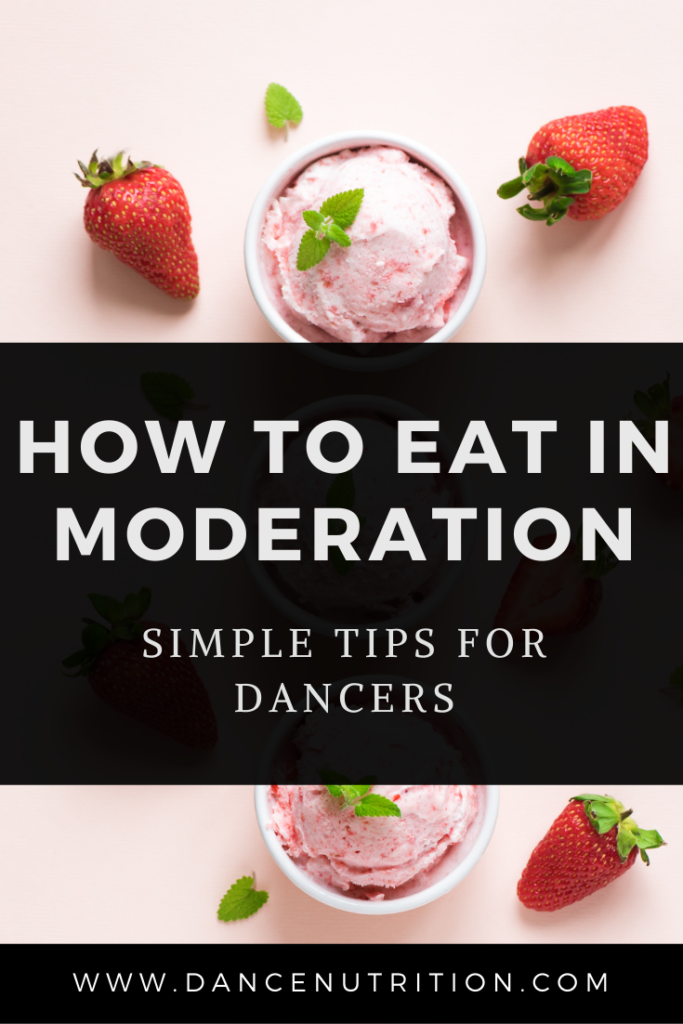It’s a simple phrase and arguably, the most common nutrition tip beloved by anyone offering advice. “self-proclaimed nutrition experts: ”Eat it, but in moderation.” The tip seems sound at first, suggesting an approach to eating that allows for ALL foods without depriving oneself. However, there’s a catch.
This simple mantra lacks the clarity and specificity necessary to guide eating and worse, mask restriction. In this blog post, we’ll uncover why the concept of moderation, as it relates to food, becomes more detrimental than beneficial, especially for a population like dancers. We will also discuss more effective strategies for healthy eating that dancers can begin implementing today.
5 Pitfalls of The “Eat In Moderation” Trap
#1: The ambiguity leads to confusion
The term “moderation” is highly subjective and can mean different things to different people. What constitutes moderation for one may be excessive or (most commonly) insufficient for another. Without clear guidelines or context, dancers may struggle to interpret how much of a particular food is “moderate” and experience subsequent guilt if perceiving oneself as eating an amount that doesn’t align with the predetermined limitation— or food rule.
#2: Moderation is code for restriction
Thanks to diet culture, we envision “moderation” as a tool for portion control— a limit on how much to eat. As with restrictive thinking, when you’re placing any limit (even one that’s moderate) on food, you’re setting yourself up to want more. Avoiding or limiting these foods increases the reward response when eating them. The result? An increase in cravings and susceptibility to eating past the point of comfort.
#3: It overlooks individuality
Every dancer has unique nutritional requirements based on factors such as age and dance intensity. What may be considered a “moderate” amount of food for one dancer could be insufficient for another. A one-size-fits-all approach like the suggestion to “eat in moderation” fails to address these differences. For many dancers, this leads to under-fueling and the risks— like RED-S, that result.
#4: It oversimplifies mealtime decisions
Focusing solely on moderation neglects the importance of a multifactorial approach to eating. As discussed in The Healthy Dancer® Food Flexibility Algorithm, food decisions are not always straightforward. Aside from evaluating what’s accessible and preferred, dancers can integrate gentle nutrition principles to optimize a dancer’s energy and performance.
#5: It doesn’t lead to behavioral change
While moderation may sound like a simple solution to navigating the complexities of mealtime decisions, its lack of specificity and guidance ultimately render it ineffective as a standalone principle to “healthy” eating. Simply advising dancers to “eat in moderation” provides little practical guidance and as mentioned earlier, risks both a restrictive mindset and under-fueling.
Key takeaways:
Instead of relying on the vague notion of “eating in moderation,” dancers can implement several strategies for a more effective approach to mealtime patterns. Eating enough each day is the most important start and can be supported alongside the work of a dietitian. Alongside this comes the need to dismantle dancer diet culture (resources linked below).
For most, it can feel scary to let go of external food limits like portion control and calorie counting. “I can’t trust myself!” is a common reason. At first, and if coming from a place of restrictive eating, it might be hard to find a comfortable middle ground between under-fueling and over-fueling. This is especially true if you haven’t yet practiced the concept of unconditional permission.
With consistent practice, however, your body will rebuild trust. It needs to know that it will receive adequate nourishment tomorrow, the next day, the next day, and so forth. Eventually, if listening to your body and staying present at some or most mealtimes, you’ll understand what feels good and what doesn’t. You’ll discover what “enough” is for you and what it means to feel satisfied.
10+ healthy eating strategies more effective than “eat in moderation.”
To learn more about swapping the “eat in “moderation” mindset with a more intuitive approach, check out this list of articles:
- Begin redefining “healthy” to continuously dismantle dancer diet culture.
- Learn how to identify the dieting mentality.
- Practice unconditional permission around all foods.
- Eat consistently and, eat enough.
- Balance your macronutrients (carbohydrates, proteins, and fats) according to individual needs.
- Utilize The Healthy Dancer® Food Flexibility Algorithm to consider all realms of mealtime decisions.
- Learn how to stop eating when you’re feeling full.
- Practice mindful eating and listening to hunger and fullness cues.
- Incorporate a variety of foods in your dancer meal plan.
- Including satisfaction as part of your balanced plate will help you to find an intuitive “moderation…” not a forced one!
- Seek support from registered dietitians for personalized nutrition advice.




